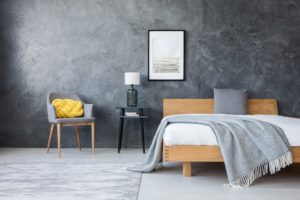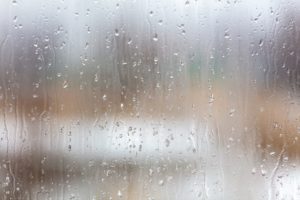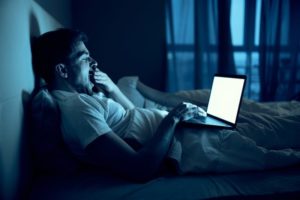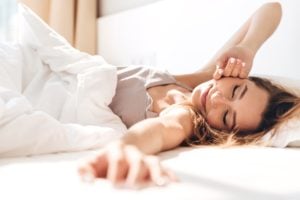What Color Light Helps You Sleep?
A dark room is best for sleep. However, in the hours before bed, warmer hues of light, such as yellows and oranges, are preferable to cooler light, like blue light from electronic devices. This is because light plays a critical role in regulating our sleep and wakefulness.
We discuss how your body’s natural sleep-wake cycle responds to different light colors and how to choose the best lighting to optimize your sleep routine.
How Does Light Affect Sleep?
Light influences the body’s natural 24-hour biological clock that controls the timing of sleep, an important component of every person’s circadian rhythm. When it is light outside, the body knows it is time to be awake, and when it is dark, the body gets ready for sleep.
Is Your Troubled Sleep a Health Risk?
A variety of issues can cause problems sleeping. Answer three questions to understand if it’s a concern you should worry about.
The rhythm of the sunrise and sunset serves as a sleep-wake signal to the body. In particular, some experts suggest that warm light from a setting sun may help to signal that it is time for sleep. The widespread use of artificial light after sunset disrupts the circadian rhythm and contributes to sleep disorders such as insomnia.
Light also affects the release of melatonin, a natural hormone that helps with sleep. The pineal gland in the brain produces melatonin in response to darkness. But, certain types of light can prevent melatonin production . Exposure to bright lights and cool-toned colors, such as blue light from cell phones, computers, and televisions, can inhibit melatonin production and keep a person awake.
However, in some instances, artificial light can be used to help people with health conditions that disrupt the circadian rhythm . Light therapy works by exposing a person to bright artificial light at specific times throughout the day in order to reset the circadian clock. Light therapy may be a treatment option for insomnia, circadian rhythm sleep disorders, seasonal depression, and even jet lag.
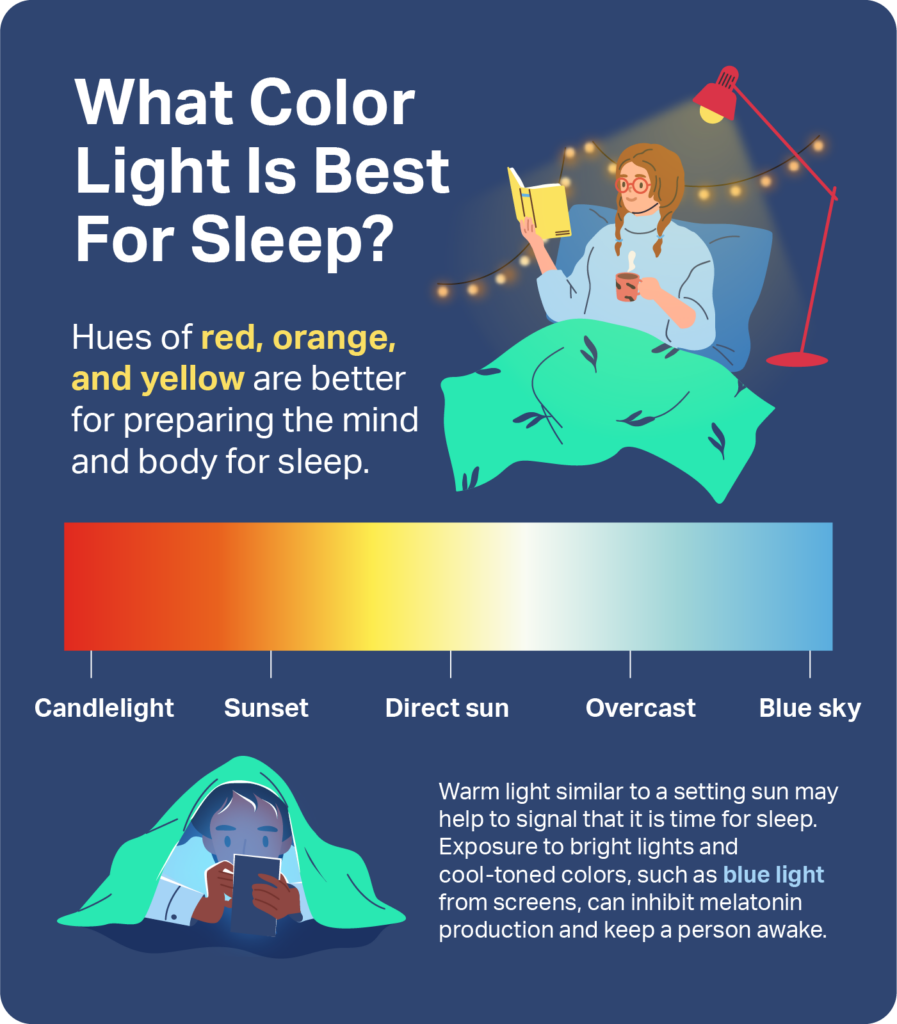
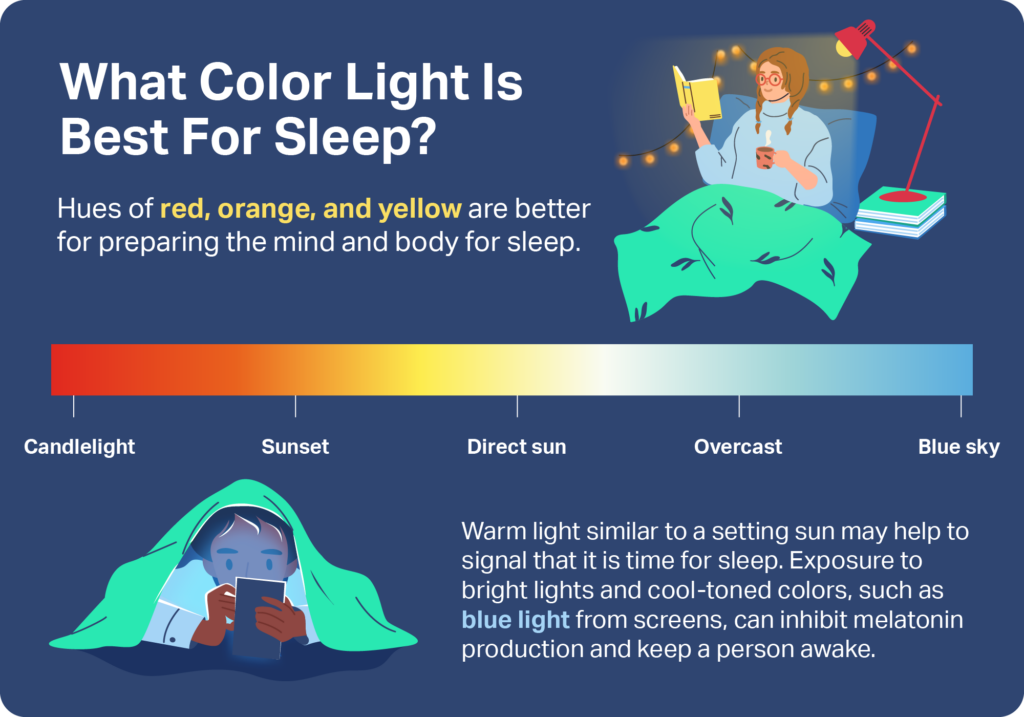
Best Color Light For Sleep
Warm hues of red, orange, and yellow are better for preparing the mind and body for sleep. In fact, some experts recommend switching to warm lights rather than cold blue lights in the home after the sun goes down. Different colors of warm light from red to yellow can affect the body in unique ways.
Red Light
Red light does not affect circadian rhythms, so it is one of the best lights to use at night. Research has shown that exposure to red light can improve sleep and increase the production of melatonin. Exposure to red light during sleep and upon waking can reduce the likelihood of feeling tired and disoriented in the morning, known as sleep inertia. However, if the red light is too bright , it can suppress melatonin production.
Yellow and Orange Light
Dim yellow and orange colored lights have little impact on the circadian rhythm and are good options to use at night. Exposure to this light may increase melatonin production, especially compared to cooler colors such as blue light.
“For a better sleep, keep your room dark, but if you need light, choose warm colors like red or amber. Avoid blue light from electronic devices as it can trick your brain into thinking it’s still daytime and disrupt your sleep-wake cycle.”
Dr. Pranshu Adavadkar, Sleep Physician
Worst Color Light for Sleep
Bright and cool-colored light can make it harder for the body to transition to a sleepy state. In contrast to warm colors that may help with sleep, cooler colors signal to the body that it is time to wake up . Since cool light encourages attention and alertness, it may prevent sleep if viewed at night.

Blue Light
Light receptors in the eye that affect the circadian rhythm are particularly sensitive to blue light . Blue light not only suppresses melatonin, it also enables the circadian rhythm to help the body maintain alertness. Regularly viewing blue light at night convinces the body that it is still daytime, which can disrupt the circadian rhythm and reduce sleep quality.
Blue light is emitted from many artificial lights and electronic screens, such as cell phones, computers, and televisions. Avoid using electronic devices that emit blue light at least one hour before bed. Additionally, consider using blue light blocking glasses, which have been shown to improve sleep among people with insomnia.
Green Light
Similar to blue light, green light also decreases drowsiness by reducing melatonin production. Although blue light can reduce melatonin levels twice as much as green light, you may still want to avoid viewing green light before bed.

Still have questions? Ask our community!
Join our Sleep Care Community — a trusted hub of sleep health professionals, product specialists, and people just like you. Whether you need expert sleep advice for your insomnia or you’re searching for the perfect mattress, we’ve got you covered. Get personalized guidance from the experts who know sleep best.
References
11 Sources
-
Bonmati-Carrion, M. A., Arguelles-Prieto, R., Martinez-Madrid, M. J., Reiter, R., Hardeland, R., Rol, M. A., & Madrid, J. A. (2014). Protecting the melatonin rhythm through circadian healthy light exposure. International Journal of Molecular Sciences, 15(12), 23448–23500.
https://pubmed.ncbi.nlm.nih.gov/25526564/ -
Lin, J., Ding, X., Hong, C., Pang, Y., Chen, L., Liu, Q., Zhang, X., Xin, H., & Wang, X. (2019). Several biological benefits of the low color temperature light-emitting diodes based normal indoor lighting source. Scientific Reports, 9(1), 7560.
https://pubmed.ncbi.nlm.nih.gov/31101840/ -
Bourgin, P., & Hubbard, J. (2016). Alerting or Somnogenic Light: Pick Your Color. PLoS Biology, 14(8), e2000111.
https://pubmed.ncbi.nlm.nih.gov/27525420/ -
Gooley, J. J., Chamberlain, K., Smith, K. A., Khalsa, S. B., Rajaratnam, S. M., Van Reen, E., Zeitzer, J. M., Czeisler, C. A., & Lockley, S. W. (2011). Exposure to room light before bedtime suppresses melatonin onset and shortens melatonin duration in humans. The Journal of Clinical Endocrinology and Metabolism, 96(3), E463–E472.
https://pubmed.ncbi.nlm.nih.gov/21193540/ -
Nussbaumer-Streit, B., Forneris, C. A., Morgan, L. C., Van Noord, M. G., Gaynes, B. N., Greenblatt, A., Wipplinger, J., Lux, L. J., Winkler, D., & Gartlehner, G. (2019). Light therapy for preventing seasonal affective disorder. The Cochrane database of systematic reviews, 3(3), CD011269.
https://pubmed.ncbi.nlm.nih.gov/30883670/ -
Sloane, P. D., Figueiro, M., & Cohen, L. (2008). Light as therapy for sleep disorders and depression in older adults. Clinical Geriatrics, 16(3), 25–31.
https://pubmed.ncbi.nlm.nih.gov/24285919/ -
Zhao, J., Tian, Y., Nie, J., Xu, J., & Liu, D. (2012). Red light and the sleep quality and endurance performance of Chinese female basketball players. Journal of Athletic Training. 2012 Nov-Dec;47(6):673-8.
https://pubmed.ncbi.nlm.nih.gov/23182016/ -
Hanifin, J. P., Stewart, K. T., Smith, P., Tanner, R., Rollag, M., & Brainard, G. C. (2006). High-intensity red light suppresses melatonin. Chronobiology International, 23(1-2), 251–268.
https://pubmed.ncbi.nlm.nih.gov/16687299/ -
Wahl, S., Engelhardt, M., Schaupp, P., Lappe, C., & Ivanov, I. V. (2019). The inner clock-Blue light sets the human rhythm. Journal of biophotonics, 12(12), e201900102.
https://pubmed.ncbi.nlm.nih.gov/31433569/ -
Goldstein, C. A. (2022, May 20). Overview of circadian sleep-wake rhythm disorders In A. D. Benca (Ed.)., Retrieved April 28, 2023, from
https://www.uptodate.com/contents/overview-of-circadian-sleep-wake-rhythm-disorders -
Horne, J. A., Donlon, J., & Arendt, J. (1991). Green light attenuates melatonin output and sleepiness during sleep deprivation. Sleep, 14(3), 233–240.
https://pubmed.ncbi.nlm.nih.gov/1896724/




